A Chimera cat is one of nature’s most mesmerizing felines, instantly recognizable by its striking split-colored face and unique coat pattern. These rare cats appear to have two different faces fused into one, often with a perfect line dividing their colors down the middle. While their appearance may seem like something out of mythology, the reason behind their one-of-a-kind look lies in feline genetics.
Chimera cats aren’t a specific breed but rather a result of genetic chimerism, a fascinating phenomenon where two separate embryos merge in the womb, creating a single cat with two sets of DNA. This genetic fusion can lead to incredible markings, mismatched eye colors, and distinctive facial symmetry. However, not all cats with a two-toned face are true chimeras, making these felines even more intriguing.
In this blog post, we’ll explore seven fascinating facts about Chimera cats, from the science behind their appearance to famous examples like Venus the Chimera Cat. Whether you’re a cat enthusiast or simply curious about nature’s rare wonders, these facts will give you a deeper appreciation for these extraordinary felines.
What Is a Chimera Cat?
Definition of a Chimera Cat
A Chimera cat is a feline that carries two distinct sets of DNA in its body, resulting in a striking and often symmetrical coat pattern. These cats typically have a face that appears split down the middle, with two different colors on each side. The term “chimera” comes from Greek mythology, where a chimera was a creature composed of multiple animals, much like how these cats seem to be a blend of two different felines. However, their unique appearance isn’t just a visual marvel—it’s the result of an unusual genetic occurrence.
Explanation of Genetic Chimerism in Cats
Genetic chimerism happens when two fertilized eggs or embryos fuse early in development, creating an individual with cells that carry different DNA sets. In Chimera cats, this means one half of their body may have a completely different genetic makeup than the other. Unlike most cats, whose cells contain only one genetic identity, Chimeras essentially have two separate genetic codes living within them.
This phenomenon doesn’t just affect coat color. It can also lead to heterochromia (two different eye colors) and variations in fur texture or pattern on opposite sides of the body. However, the only way to confirm if a cat is a true Chimera is through DNA testing, which can reveal the presence of two distinct genetic profiles.
How It Differs from Other Unique Feline Markings
Many cats have striking coat patterns, but not all of them are Chimeras. Some cats with split-colored faces or unusual markings owe their appearance to other genetic processes, such as X-inactivation. This occurs in female tortoiseshell and calico cats, where different X chromosomes activate in different parts of the body, creating a multi-colored effect. However, these cats still have only one genetic identity, unlike true Chimeras.
Similarly, cats with naturally occurring mosaicism can display two-toned fur without being true Chimeras. Mosaic cats develop their unique coloring due to random mutations in cell division, but they don’t carry two distinct sets of DNA. While their appearance might resemble that of a Chimera, genetic testing is necessary to distinguish between the two.
Chimera cats stand out because their genetic makeup is genuinely different on each side of their body. This makes them one of the most fascinating examples of how genetics can create truly one-of-a-kind creatures.
The Science Behind The Chimera Cat
The Role of Genetic Mutation in Cats
Genetic mutations play a key role in the development of Chimera cats. Unlike typical mutations that alter a single gene or chromosome, chimerism results from the merging of two embryos, each carrying its own unique genetic code. This fusion creates a cat with two separate sets of DNA, leading to the characteristic split-colored face or body. Some Chimeras display differences in fur texture, paw color, or even organ DNA variations, making them one of the most visually and biologically unique felines.
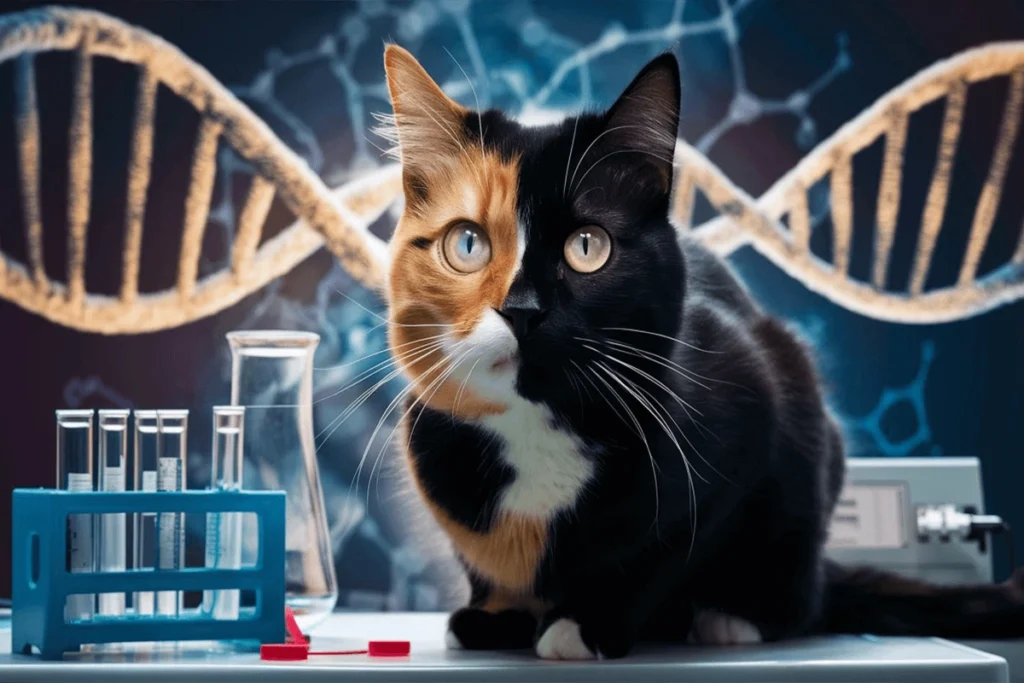
Explanation of X-Inactivation and How It Affects Coat Patterns
Many people confuse Chimera cats with tortoiseshell and calico cats, which also have multi-colored coats. However, their patterns result from X-inactivation, a natural process in female cats. Since female cats inherit two X chromosomes (one from each parent), one X chromosome randomly deactivates in each cell, leading to patches of different colors in their fur. This process explains why tortoiseshell and calico cats have mixed patterns but still retain a single genetic identity.
In contrast, Chimera cats don’t rely on X-inactivation for their coloration. Their appearance results from the fusion of two genetically distinct embryos, meaning each half of their body may carry a completely different DNA set. Male Chimera cats can exist, unlike tortoiseshell and calico males, which are extremely rare due to the requirement of two X chromosomes.
Connection to Tortoiseshell and Calico Cats
While tortoiseshell and calico cats share some visual similarities with Chimera cats, they are not the same. True Chimeras have genetic material from two different individuals, while tortoiseshell and calico cats inherit their patterns through standard feline genetics.
One of the easiest ways to tell them apart is symmetry. Chimera cats often have a perfectly split face, with two distinct colors divided almost equally. Tortoiseshell and calico cats, on the other hand, have random blotches of color spread throughout their bodies. While both types of cats are undeniably stunning, true Chimeras are far rarer and genetically unique.
Is Chimera Cat a Rare Breed?
Does Chimera Cat Belongs to a Specific Breed or Occur Across Multiple Breeds?
Chimera cats don’t belong to a specific breed. Instead, genetic chimerism can appear in any breed of domestic cats (Felis catus). Since chimerism results from the fusion of two embryos during early development, it can occur in both purebred and mixed-breed cats. Unlike breeds with defined physical traits—such as the Siamese with its pointed coat pattern or the Maine Coon with its large, fluffy frame—Chimera cats don’t follow a predictable set of characteristics beyond their genetic anomaly.
Because chimerism happens at random, you might find a Chimera among Persians, Bengals, Maine Coons, or even regular domestic shorthairs. Their defining feature isn’t their breed but rather their split-colored cat appearance, which stems from the presence of two different sets of DNA.
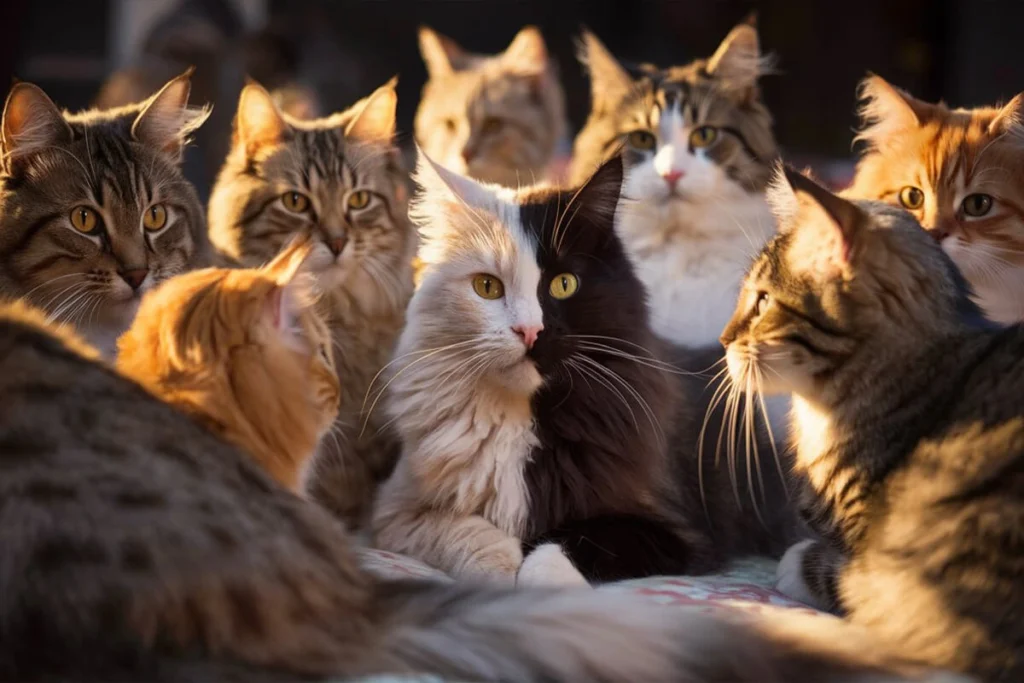
How Rare Is the Split-Colored Chimera Cat Appearance?
True Chimera cats remain incredibly rare. While many cats have striking coat patterns, few actually possess two genetically distinct sets of DNA. The classic two-faced cat look, where each side of the face appears in dramatically different colors, happens only in a small percentage of felines. Even when chimerism does occur, the visible expression of the condition varies. Some Chimera cats may show the genetic difference internally, affecting organ DNA rather than fur coloration.
For a Chimera cat to display a perfect split down the middle, multiple factors must align during early embryonic development. This makes Chimera cats with a Venus-like appearance—half black and half orange, often with mismatched eyes—especially rare. Many cats with two-toned faces owe their look to other genetic factors, not true chimerism.
Misconceptions About Chimera Cats Being a Separate Breed
Many people mistakenly believe that Chimera cats belong to a specific breed due to their distinct appearance. However, chimerism is not a breed trait; it’s a genetic condition that can happen in any cat. Some breeders and cat enthusiasts mistakenly label certain split-colored cats as “Chimera breed” felines, but no official Chimera cat breed exists.
Another common misconception is that all cats with two different facial colors or mismatched eyes must be Chimeras. In reality, other genetic conditions—such as mosaicism or X-inactivation—can create a similar effect. Only a DNA test can confirm whether a cat is a true Chimera, as their two sets of DNA provide definitive proof of the phenomenon.
While Chimera cats don’t belong to an exclusive breed, their rarity and unique look make them one of the most fascinating felines in the world.
Famous Chimera Cats: Venus and Others
Venus the Chimera Cat: The Internet’s Most Famous Two-Faced Feline
When people think of a Chimera cat, Venus instantly comes to mind. Venus the Chimera Cat became an internet sensation thanks to her perfectly split-colored face—one side jet black with a green eye, the other side orange tabby with a blue eye. Her striking appearance, combined with her unusual eye colors, made her one of the most recognizable cats in the world.
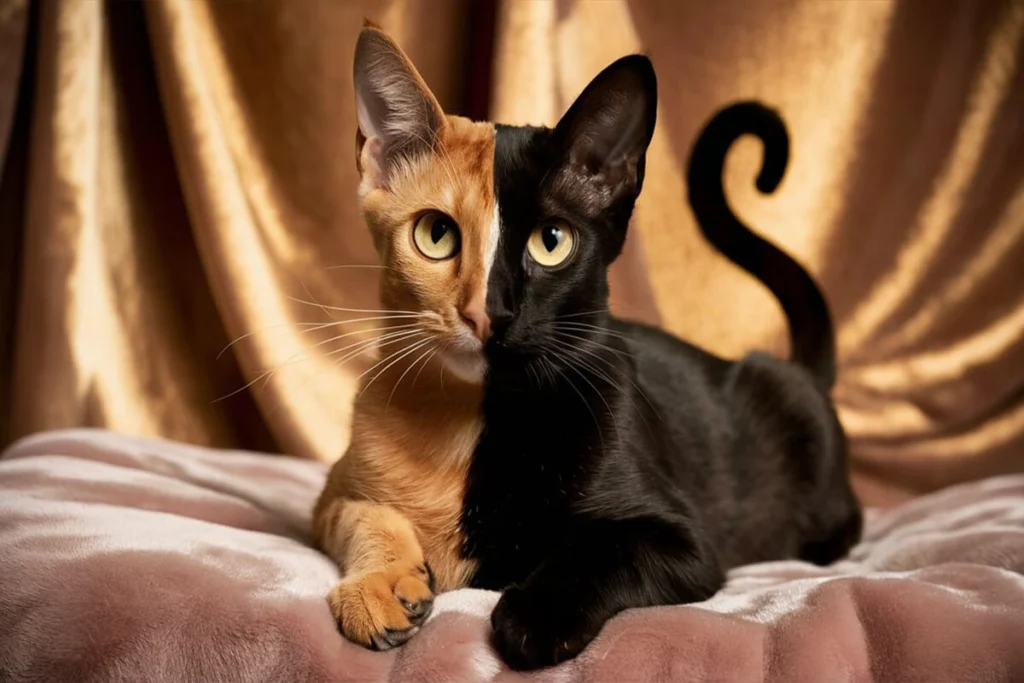
Venus first gained popularity in 2012 when her owner shared photos and videos of her online. People immediately speculated whether she was a true Chimera or simply a cat with a rare coat pattern. While Venus has never undergone DNA testing to confirm her genetic makeup, her perfectly divided face and heterochromatic eyes align with traits often seen in Chimera cats. Regardless of her genetic status, she has helped introduce millions of people to the concept of genetic chimerism in cats.
Venus’s rise to fame led to appearances in magazines, TV shows, and even merchandise featuring her distinctive face. She continues to have a strong presence on social media, proving that people remain fascinated by the beauty of Chimera cats.
Other Well-Known Chimera Cats with Striking Appearances
Venus isn’t the only Chimera cat that has captured public attention. Several other two-faced felines have gained fame for their rare looks and genetic uniqueness.
- Quimera – Another well-known Chimera cat, Quimera, resembles Venus but has even more dramatic features. Her face is perfectly divided, with one half black and the other orange, and her eyes are different colors as well. Unlike Venus, her body also displays a clear split between her fur colors. Quimera’s beauty has made her a social media star with thousands of dedicated followers.
- Narnia – A stunning British Shorthair with a flawless blue-gray and black split face, Narnia differs from other Chimera cats because of his deep blue eyes. His owner had his DNA tested, confirming that he carries two genetic profiles, making him a true Chimera. Narnia has since fathered kittens, some of which inherited unique coat patterns, although none share his exact two-toned face.
- Yana – Nicknamed “the two-faced cat,” Yana has a dramatic color split, making her look like she was painted in two separate shades. Unlike Venus and Quimera, her eyes remain the same color, but her markings still make her a striking example of genetic chimerism in cats.
These cats, along with Venus, prove that nature can create some truly extraordinary feline patterns.
How Social Media Has Popularized These Rare Felines
Before the rise of social media, most people had never heard of a Chimera cat. While some cat lovers and geneticists understood the phenomenon, the general public didn’t know much about these unique felines. Platforms like Instagram, TikTok, and YouTube have changed that by bringing two-faced cats into the spotlight.
When Venus went viral, people became more curious about Chimera cats and started sharing photos of other felines with split-colored faces. This exposure led to increased discussions about feline genetics, genetic chimerism, and how these rare cats come into existence. Scientists and veterinarians even started weighing in, helping to debunk myths and educate people about the real science behind these extraordinary cats.
Many pet owners now look for Chimera cats in shelters or from breeders, hoping to find a cat with a similar split-colored appearance. However, since true Chimera cats are extremely rare, most of these cats turn out to have X-inactivation or mosaicism instead of genetic chimerism. Even so, social media has helped people appreciate all cats with unique markings, whether they are true Chimeras or not.
The popularity of Chimera cats on social media has also led to new trends, including artwork, merchandise, and even memes inspired by these two-faced felines. As more rare and stunning Chimera cats emerge online, their mystery and beauty continue to captivate cat lovers worldwide.
How to Identify a Chimera Cat
Differences Between a True Chimera and a Cat with Unique Markings
Many cats display striking two-toned faces or unique fur patterns, but not all of them qualify as true Chimera cats. A true Chimera cat possesses two distinct sets of DNA due to the fusion of two embryos during early development. This means different parts of its body can contain cells with entirely separate genetic identities.
On the other hand, some cats develop split-colored coats due to other genetic factors, such as X-inactivation or mosaicism. For example, many tortoiseshell and calico cats have multi-colored fur because of X-inactivation, which randomly deactivates one X chromosome in each cell, creating patches of different colors. While these cats may look like Chimera cats, they still have only one genetic identity.
Mosaic cats also develop unique markings, but instead of carrying two sets of DNA, they experience random mutations that cause variations in coat color. Unlike true Chimeras, these cats do not originate from the fusion of two embryos, making them genetically different from real Chimera cats.
One of the key visual clues that set Chimera cats apart is facial symmetry. Many true Chimeras, like Venus the Chimera Cat, have a nearly perfect split down the middle of their face, with one side appearing completely different from the other. However, some Chimeras do not display this feature externally, making DNA testing the only reliable way to confirm their genetic makeup.
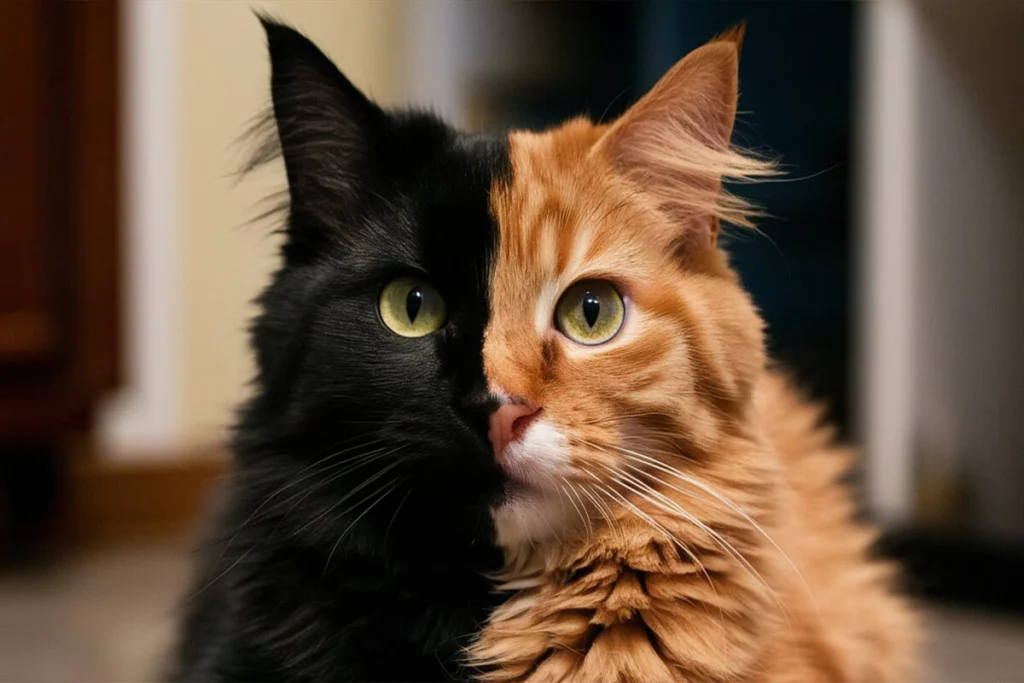
The Role of DNA Testing in Confirming Chimerism
Although a cat may look like a Chimera cat, only a DNA test can confirm whether it carries two sets of genetic material. Veterinarians and geneticists can conduct DNA testing by analyzing different parts of a cat’s body, such as fur, saliva, or even organ tissue.
To prove genetic chimerism, scientists take DNA samples from multiple areas of the cat’s body—such as a cheek swab and a blood sample—and compare them. If the samples contain two distinct sets of DNA, the cat qualifies as a true Chimera. If all samples show a single genetic profile, the cat likely has a unique coat pattern caused by other genetic factors rather than chimerism.
This process has confirmed chimerism in some famous Chimera cats, such as Narnia, a British Shorthair with a stunning blue-gray and black split face. Narnia underwent genetic testing, and scientists verified that he carries two separate DNA profiles.
Since genetic chimerism does not always manifest in a cat’s fur pattern, some true Chimeras may never be identified unless tested. Some may carry their second DNA set internally, affecting their organs or reproductive cells without any visible difference in their fur.
Common Physical Traits of Chimera Cats
While DNA testing offers the most definitive proof of genetic chimerism, some physical traits often indicate that a cat might be a Chimera cat. These include:
- Split-Colored Face – One of the most striking traits of a Chimera cat is a sharply divided face with two distinct colors. Many of these cats have one side that is dark (often black) and the other side that is lighter (such as orange or tabby-patterned). This symmetrical contrast makes them highly recognizable.
- Heterochromia (Two Different Eye Colors) – Some Chimera cats exhibit heterochromia, a condition where each eye has a different color. One eye may appear green while the other is blue or amber. This occurs when the two sets of DNA influence pigment development in separate parts of the body. However, not all Chimera cats have heterochromia, and some non-Chimeras can also develop this feature due to other genetic reasons.
- Mismatched Fur Patterns on the Body – In addition to their faces, some Chimera cats have strikingly different fur patterns on each side of their body. Their legs, paws, or even tails may show distinct color divisions, further highlighting their dual genetic identities.
- Differences in Paw Color – Some Chimera cats have paws that don’t match, such as one black paw and one orange or white paw. This occurs because each side of their body follows a different genetic code.
- Variations in Skin or Organ DNA – Although not visible externally, some Chimera cats have internal differences, such as reproductive organs carrying one genetic identity while their skin or fur carries another. This can lead to rare cases where a female Chimera cat gives birth to kittens that do not match her apparent genetics, as her reproductive system may follow her second DNA set.
Conclusion
Chimera cats captivate people with their rare and mesmerizing appearances, but their uniqueness goes far beyond their striking fur patterns. These extraordinary felines carry two sets of DNA, making them genetic marvels unlike any other cats. Their split-colored faces, mismatched eyes, and distinct fur markings result from a rare fusion of two embryos, creating a single cat with two separate genetic identities.
Although many people associate Chimera cats with a specific breed, chimerism can occur in any breed, from domestic shorthairs to pedigreed felines. Their appearance often leads to confusion with tortoiseshell and calico cats, whose coats form due to X-inactivation, but true Chimera cats are genetically distinct. Only a DNA test can confirm whether a cat is a real Chimera, as some may carry their second genetic identity internally without any visible signs.
Social media has played a major role in popularizing Chimera cats, with famous felines like Venus, Quimera, and Narnia gaining millions of fans worldwide. Their unique looks have sparked curiosity about feline genetics, leading more people to appreciate the science behind these beautiful animals. While true Chimera cats remain rare, their existence highlights the complexity of nature and how genetics can create stunning and unexpected variations in animals.
Whether they are true Chimeras or simply have rare markings, these cats remind us of the beauty and unpredictability of genetic diversity. Their popularity continues to grow, proving that the world never tires of discovering and celebrating nature’s most extraordinary creations.
Read About the Latest Tips For All Different Cats From HERE.
Can Cats Eat Cheese ? Read About this Topic on this Article.
Looking For Some Good stuff for your Pet? Look no Further and pay Pet MD Official a Visit.
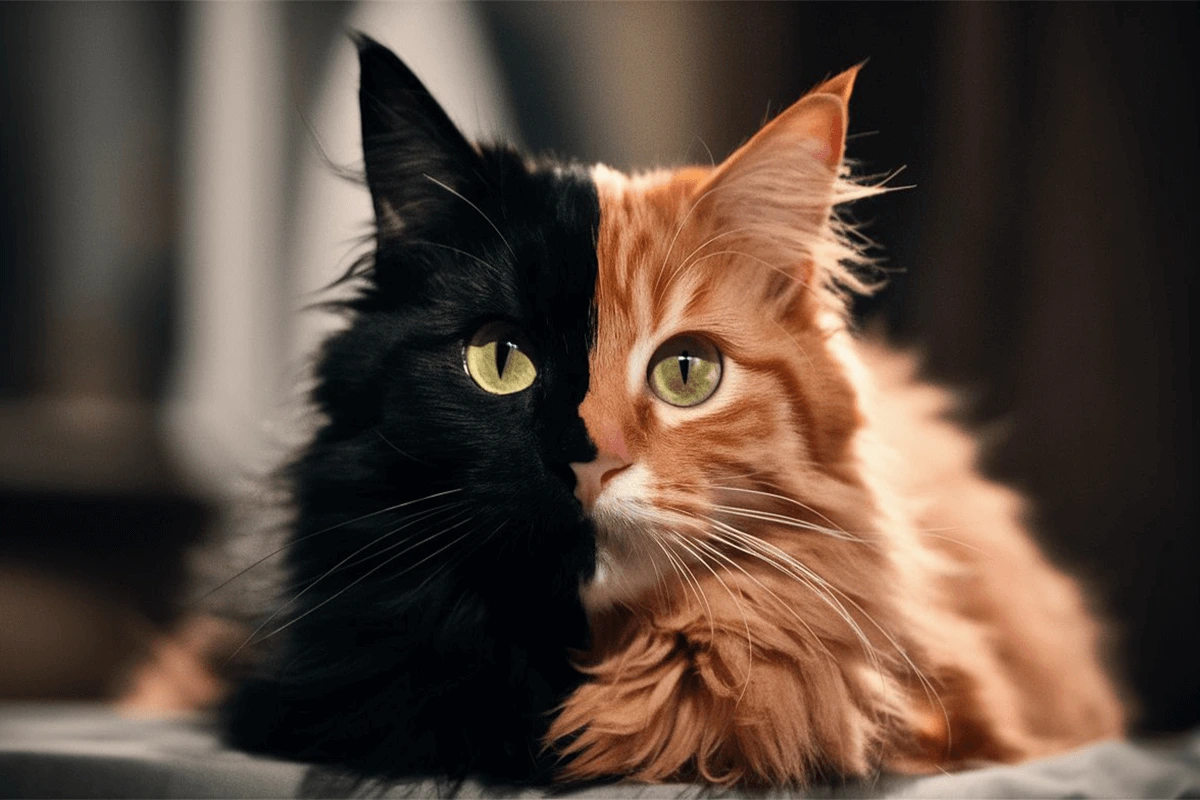
4 thoughts on “Chimera Cat: 7 Fascinating Facts About this Cat You need to know”
Comments are closed.